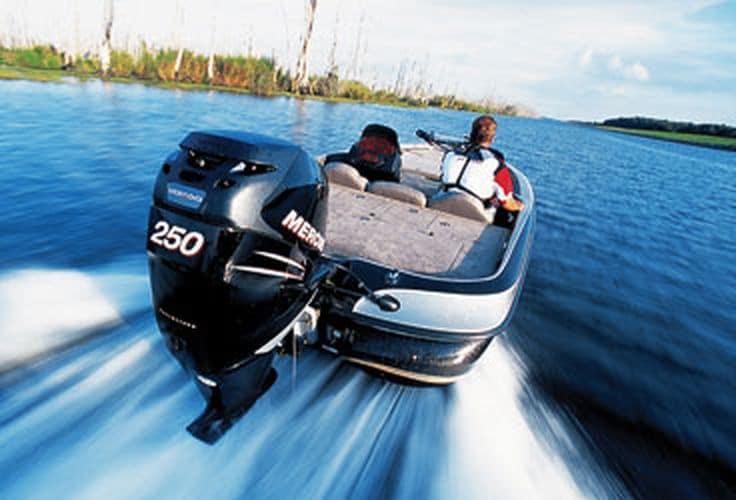Boats are extremely popular among young and middle-aged adults. These high-ticket items make them out-of-reach for many consumers. Instead of opting out altogether, consumers will invest in preowned models. When you consider the fact, boats are oftentimes seasonal, it does make sense to opt for older models.
Regardless if you are planning on a new or preowned model, there are some very important factors to consider. These factors include the type of motor, size, storage, budget, versatility, usability, and maintenance.
When it comes to a motor-driven boat, it is pertinent to know your options. There are three primary types of boat motors – outboard, inboard, and hybrid. Depending on your plans, the outboard motor may be exactly what you need to get the most out of your new boat.
However, you may decide that the inboard or hybrid motor maybe your best option. But, first, you need to know the ins and outs of each motor before you can even consider making a decision.
Outboard Boat Motor
If your future boating plans are geared toward recreation, the outboard motor could be your best option. The outboard motor is commonly utilized in recreational vessels like the fishing boat. One of the biggest benefits of the outboard motor is accessibility, as it is installed in the hull.
When it comes to routine maintenance and repairs, the rear-mounting position ensures quick and easy accessibility. In addition to the easy accessibility, the outboard motor is integrated with a handle grip to ensure better tilting and steering.
You may also appreciate the fact, the outboard motor is designed to offer easy storage. The propellers can be lifted completely out of the water. Not only does this capability ensure easier storage but also longevity. Instead of being continuously exposed to water and other elements, outboard motor propellers are stored in the upward position.
When propellers are continuously sitting in water when the boat is not in use, marine growth will always be an issue. As the marine growth begins to build upon the surface of the blades, it will begin to weigh down the propellers, resulting in poor performance.
Another benefit of the out-of-water propeller position is easy maintenance. You can repair, maint, or replace the outboard motor without needing to dry dock the boat in advance. Last, but not least, the reliability of the outboard motor is undeniably remarkable.
Like pros, the outboard motor has a few downsides as well. One particular downside that comes to mind is less power, which is why large boats are generally installed with inboard or hybrid motors. Another downside is high fuel consumption. Since the outboard motor is generally larger than inboard motors, you can expect to have less room on the boat for entertaining.
Inboard Boat Motor
Inboard motors utilize a separate rudder for steering, resulting in a low center of gravity. This design makes the inboard motor more friendly to smaller boats, personal watercraft vessels, surfers, and jet skiers because of their smaller wake.
Inboard motors support large yachts, commercial watercraft, and powerful motorboats. While the inboard motor can generate sufficient power for larger vessels, its larger footprint requires more space, making the larger vessel the better option.
The fuel-efficiency design makes the inboard motor the more environmentally-friendly option, compared to the outboard motor. The fuel-efficiency rating is contributed to the design, which replicates the automotive engine. In addition to the low fuel consumption, the inboard motor generates more horsepower and torque than the outboard motor.
The biggest downside of the inboard motor is its high price tag. The average price of an inboard boat motor is $10,000. However, some models are priced above $20,000.
Last, but not least, the inboard motor has been linked to more boat fires than the hybrid and outboard motors. The fire hazard can be minimized with a bilge blower, which will force a higher volume of air into the bilge.
Hybrid Boat Motor
The hybrid motor is ideal for consumers who have no interest in the inboard and outboard motors. The hybrid design replicates the outboard motor but comes with downsides similar to the inboard motor. Like the outboard motor, the hybrid motor is commonly installed in recreational watercraft like the small fishing boat. When compared to the outboard motor, the hybrid utilizes a propeller shaft that runs through the main bottom of the water vessel’s hull.
Like the inboard motor, the hybrid is inconveniently positioned.
Read Also: What Safety Precaution Should You Take When Hunting From A Boat?
Which Of The Following Is Recommended Maintenance For An Inboard Boat?
Inboard Motor Maintenance Tips
The position of the inboard motor creates a complicated upgrade, replacement, repair, and maintenance. Just to access the inboard motor is a complicated process. On the exterior surface of the hull, the inboard motor is difficult to access. Since there is no option to lift the inboard motor out of the water, the propellers are continuously exposed to the elements.
In addition to the element exposure, marine growth is a major issue for the inboard motor. In fact, marine growth is so problematic for the inboard that it could lower the ship’s frictional resistance performance. Fortunately, marine growth buildup can be prevented by following the maintenance tip below:
- Routine Cuprous Thiocyanate Treatment – Routinely apply a generous layer of cuprous thiocyanate to every inch of the propeller. To achieve the maximum results, the treatment should be repeated bi-annually. For maximum results, the treatment should be repeated three times per year.
- Anti-Fouling Paint And Finish – If you opt to invest in a preowned boat, you should immediately upgrade the inboard propeller with a fresh layer of anti-fouling paint, followed by a finish. These products are designed to combat organism growth – algae, barnacle, and mussel – on the boat’s hull.
- Regular Oil Changes – Routine oil changes improve gas mileage and motor performance, extend the life of the motor, removes sludge and motor particles related to normal wear, and reduces the ship’s carbon footprint.
- Lubricate Gears Annually – Experts recommend annual gear lubrication to fight against wear related to excessively high summer temperatures. The gear lubricant will also prevent friction, noise, and poor performance.
- Freshwater Flushing – The elements found in freshwater will cause corrosion and contamination buildup in the inboard motor’s cooling system. Following the step-by-step instructional guide include in the owner’s manual, flush the boat’s cooling system by introducing a freshwater flush in the inboard engine. The only way the process will work is if the engine is running.
- Winterizing – Recreational boats are seasonal watercraft, meaning they are docked throughout the winter season. Winter temperatures can take their toll on an inboard engine if not properly winterized.
This process removes freshwater or saltwater from the engine’s cooling system to prevent freezing when temperatures drop to 32 degrees Fahrenheit and below. Antifreeze is introduced to the engine to combat freezing.
- Replacing Spark Plugs – Experts recommend spark plug replacement at least once per year or every 100 hours of operation. Spark plugs sustain damage every time the inboard engine is cranked.
Other factors related to malfunctioning spark plugs include overheating, water and dirt, malfunctioning fuel filter, and improper gap. Spark plug replacement offers an array of benefits, including better fuel efficiency and starts and lower greenhouse gas emissions.
- Exterior Cleaning – Your exterior is exposed to various elements that can negatively impact the integrity of the boat. Freshwater elements, such as sulfur, chloride, sodium, calcium, magnesium, dirt, and grim will dull and scratch the exterior finish.
Regular cleaning will go a long way in combating the damage caused by the elements. Utilizing a gentle marine cleaner and sponge, gently clean every inch of the exterior, followed by a thorough rinse.
- Hull Cleaning – Marine growth like algae will build upon the boat’s hull if not properly cleaned at least every four weeks. Utilizing a marine-safe cleaner and brush, scrub the hull to remove any potential marine buildup and stains. Follow up with a gel coat, which should be applied generously with a clean cloth.
- Interior Cleaning – If your boat is stored outdoors when not in use, the elements will eventually take their toll on interior surfaces and components. While manufacturers utilize marine-grade vinyl material – seats and cushions – sun, wind, rain, snow, dirt, and debris exposure will dull the interior over time.
Utilizing a marine-grade cleaner and sponge, gently clean every inch of the interior. Follow up with a marine-grade vinyl conditioner to combat element damage.
- Canvas Cleaning – Most boat manufacturers utilize canvas material to cover the cockpit and other vulnerable areas. It is recommended to clean the canvas twice per year utilizing a marine-grade, PVC-free cleaner.
Utilizing a soft brush and a mild soap to remove stains, marine growth buildup, and other debris. Rinse thoroughly with water and allow to completely dry before applying the canvas protector spray or cream.
- Hose Inspection – Boats utilize fuel, bilge, sanitation, thru-hull, and freshwater hoses that are constantly exposed to the elements. Like a vehicle, boat hoses have a tendency to wear down over time, which is where regular visual inspections come into play.
Carefully inspect each hose, looking for signs of deterioration like cracks. This is the first sign of a future leak. Carefully bend each hose to determine its level of flexibility. When hoses begin to wear down, they tend to harden and crack.
Afterword
Unfortunately, too many owners ignore their boats’ needs. This oversight may be contributed to offsite storage like docks. If you reside in a community with homeowner association restrictions, you are probably not permitted to store a boat in your driveway.
This is very common in suburban and metropolis areas, which is very unfortunate because it hinders the boat’s maintenance routine. Inboard and outboard boats require a lot of upkeep that many people find overwhelming and time-consuming.
Interesting Read: How to get rid of fiberglass boat.

Ever wondered how you can have a cruising boat without getting into financial problems? The answer is here. That is the reason why we set up this blog to share with you, safety tips, answers to questions that have to do with fishing and hunting. You are going to love it!
Hey! I am Armstrong!

